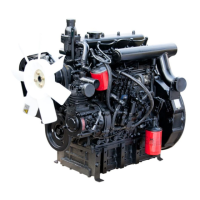MAINTENANCE MANUAL OF ENGINE
128
Operating principle:
a. Non-charging state: With the power switch
turned on, the excitation current flows as follows:
battery +--k---charging indicator lamp-regulator
(live terminal--contact--"field" termi-
nal)--excitation winding--ground strap--battery "-".
(Separate excitation, indicator lamp On) see the
figure.
b. Charging state: With the alternator operated, it
voltage rises at output end of the three excitation
diodes as the speed increases, and the charging
indicator lamp brightness gets weaker; when the
alternator voltage is up to the battery charging
voltage, the alternator is switched to
self-excitation mode, and the indicator lamp is off.
On one hand, after rectification by d1-d6 diodes, a
DC current voltage is output to the battery for
charging; on other hand, after rectification by d7,
d8 and d9 excitation diodes, and d2, d4 and d6
negative diodes, the excitation circuit is energized.
Function of the charging indicator lamp:
a. The indicator lamp gets on if the operator for-
gets turning off the power switch;
b. The indicator lamp gets off when the alternator
is operated normally;
c. The indicator lamp gets on due to voltage rise at
both ends of the indicator lamp when the alterna-
tor speed decreases or is failed.
Conclusion: The functions of the charging indica-
tor lamp are as follows:
a. Remind the driver of turning off the power
switch in time;
b. Indicate operating state of the alternator.
Voltage regulator
The regulator can be categorized into fol-
lowing types in terms of structural pattern: elec-
tromagnetic vibration type regulator, transistor
regulator and integrated circuit type regulator.
Electromagnetic vibration type regulator:
The make/break of the electromagnetic contact is
controlled by the voltage magnitude of the alter-
nator, so as to control current intensity of the field
coil and change magnitude of the voltage output
from the alternator, enabling the voltage to be kept
within limit at high speed of the alternator and not
to increase as the speed increases.
Transistor regulator: The excitation current
is switched on and off by use of the transistor to
output a constant voltage. Compared to the elec-
tromagnetic vibration type regulator, the transistor
regulator boasts a better regulating performance,
without provision of the electric magnet with
complicated structure and slow action, of contact
liable to be burned. Due to light weight, small
volume, high reliability, long service life and
small radio interference and etc., it acts as an ex-
ternal regulator, which is widely substituted for
the electromagnetic vibration regulator.
Integrated circuit type regulator: It is fab-
ricated by use of semi-conductor technique or
lamina technique and encapsulating the transistor,
resistor, capacitor and other components onto a
silicon or insulator substrate as per circuit re-
quirements. It features high reliability and integra-
tion degree, which is usually installed in the al-
ternator as a built-in regulator.

